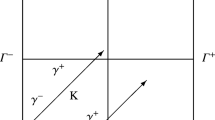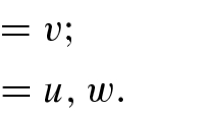Abstract
In this paper, we shall establish the superconvergence property of the Runge–Kutta discontinuous Galerkin (RKDG) method for solving a linear constant-coefficient hyperbolic equation. The RKDG method is made of the discontinuous Galerkin (DG) scheme with upwind-biased numerical fluxes coupled with the explicit Runge–Kutta algorithm of arbitrary orders and stages. Superconvergence results for the numerical flux, cell averages as well as the solution and derivative at some special points are shown, which are based on a systematical study of the \(\hbox {L}^2\)-norm stability for the RKDG method and the incomplete correction techniques for the well-defined reference functions at each time stage. The result demonstrates that the superconvergence property of the semi-discrete DG method is preserved, and the optimal order in time is provided under the smoothness assumption that is independent of the number of stages. As a byproduct of the above superconvergence study, the expected order of the post-processed solution is obtained when a special initial solution is used. Some numerical experiments are also given.
Similar content being viewed by others
References
Adams, R.A.: Sobolev spaces. In: Pure and Applied Mathematics, vol. 65, Academic Press, New York (1975)
Cao, W., Li, D., Yang, Y., Zhang, Z.: Superconvergence of discontinuous Galerkin methods based on upwind-biased fluxes for 1D linear hyperbolic equations. ESAIM Math. Model. Numer. Anal. 51, 467–486 (2017)
Cao, W., Shu, C.-W., Yang, Y., Zhang, Z.: Superconvergence of discontinuous Galerkin methods for two-dimensional hyperbolic equations. SIAM J. Numer. Anal. 53, 1651–1671 (2015)
Cao, W., Shu, C.-W., Yang, Y., Zhang, Z.: Superconvergence of discontinuous Galerkin method for scalar nonlinear hyperbolic equations. SIAM J. Numer. Anal. 56, 732–765 (2018)
Cao, W., Shu, C.-W., Zhang, Z.: Superconvergence of discontinuous Galerkin methods for 1-D linear hyperbolic equations with degenerate variable coefficients. ESAIM Math. Model. Numer. Anal. 51, 2213–2235 (2017)
Cao, W., Zhang, Z.: Some recent developments in superconvergence of discontinuous Galerkin methods for time-dependent partial differential equations. J. Sci. Comput. 77, 1402–1423 (2018)
Cao, W., Zhang, Z., Zou, Q.: Superconvergence of discontinuous Galerkin methods for linear hyperbolic equations. SIAM J. Numer. Anal. 52, 2555–2573 (2014)
Cheng, Y., Meng, X., Zhang, Q.: Application of generalized Gauss–Radau projections for the local discontinuous Galerkin method for linear convection-diffusion equations. Math. Comput. 86, 1233–1267 (2017)
Cheng, Y., Shu, C.-W.: Superconvergence and time evolution of discontinuous Galerkin finite element solutions. J. Comput. Phys. 227, 9612–9627 (2008)
Cheng, Y., Shu, C.-W.: Superconvergence of discontinuous Galerkin and local discontinuous Galerkin schemes for linear hyperbolic and convection-diffusion equations in one space dimension. SIAM J. Numer. Anal. 47, 4044–4072 (2010)
Choi, M.D.: Tricks or treats with the Hilbert matrix. Am. Math. Mon. 90, 301–312 (1983)
Ciarlet, P.G.: The finite element method for elliptic problems. In: Studies in Mathematics and Its Applications, vol. 4, North-Holland Publishing Co., Amsterdam (1978)
Cockburn, B.: An introduction to the discontinuous Galerkin method for convection-dominated problems, In: Advanced Numerical Approximation of Nonlinear Hyperbolic Equations (Cetraro, 1997), Lecture Notes in Mathematics, vol. 1697, Springer, Berlin, pp. 151–268 (1998)
Cockburn, B.: Discontinuous Galerkin methods for convection-dominated problems, In: High-Order Methods for Computational Physics, Lecture Notes Computer Science Engineering, vol. 9, Springer, Berlin, pp. 69–224 (1999)
Cockburn, B., Hou, S., Shu, C.-W.: The Runge–Kutta local projection discontinuous Galerkin finite element method for conservation laws. IV. The multidimensional case. Math. Comput. 54, 545–581 (1990)
Cockburn, B., Lin, S.Y., Shu, C.-W.: TVB Runge–Kutta local projection discontinuous Galerkin finite element method for conservation laws. III. One-dimensional systems. J. Comput. Phys. 84, 90–113 (1989)
Cockburn, B., Luskin, M., Shu, C.-W., Süli, E.: Enhanced accuracy by post-processing for finite element methods for hyperbolic equations. Math. Comput. 72, 577–606 (2003)
Cockburn, B., Shu, C.-W.: TVB Runge–Kutta local projection discontinuous Galerkin finite element method for conservation laws. II. General framework. Math. Comput. 52, 411–435 (1989)
Cockburn, B., Shu, C.-W.: The Runge–Kutta local projection \(P^1\)-discontinuous-Galerkin finite element method for scalar conservation laws. RAIRO Modél. Math. Anal. Numér. 25, 337–361 (1991)
Cockburn, B., Shu, C.-W.: The Runge–Kutta discontinuous Galerkin method for conservation laws. V. Multidimensional systems. J. Comput. Phys. 141, 199–224 (1998)
Cockburn, B., Shu, C.-W.: Runge–Kutta discontinuous Galerkin methods for convection-dominated problems. J. Sci. Comput. 16, 173–261 (2001)
Gottlieb, S.: Strong stability preserving time discretizations: a review. In: Spectral and High Order Methods for Partial Differential Equations—ICOSAHOM 2014, Lecture Notes Computer Science Engineering, vol. 106, Springer, Cham, pp. 17–30 (2015)
Gottlieb, S., Ketcheson, D.I., Shu, C.-W.: High order strong stability preserving time discretizations. J. Sci. Comput. 38, 251–289 (2009)
Gottlieb, S., Shu, C.-W., Tadmor, E.: Strong stability-preserving high-order time discretization methods. SIAM Rev. 43, 89–112 (2001)
Guo, L., Yang, Y.: Superconvergence of discontinuous Galerkin methods for linear hyperbolic equations with singular initial data. Int. J. Numer. Anal. Model. 14, 342–354 (2017)
King, J., Mirzaee, H., Ryan, J.K., Kirby, R.M.: Smoothness-increasing accuracy-conserving (SIAC) filtering for discontinuous Galerkin solutions: improved errors versus higher-order accuracy. J. Sci. Comput. 53, 129–149 (2012)
Meng, X., Ryan, J.K.: Discontinuous Galerkin methods for nonlinear scalar hyperbolic conservation laws: divided difference estimates and accuracy enhancement. Numer. Math. 136, 27–73 (2017)
Meng, X., Shu, C.-W., Wu, B.: Optimal error estimates for discontinuous Galerkin methods based on upwind-biased fluxes for linear hyperbolic equations. Math. Comput. 85, 1225–1261 (2016)
Meng, X., Shu, C.-W., Zhang, Q., Wu, B.: Superconvergence of discontinuous Galerkin methods for scalar nonlinear conservation laws in one space dimension. SIAM J. Numer. Anal. 50, 2336–2356 (2012)
Qiu, J., Zhang, Q. Stability, error estimate and limiters of discontinuous Galerkin methods. In: Handbook of Numerical Methods for Hyperbolic Problems, Handbook of Numerical Analysis, vol. 17, Elsevier, Amsterdam, pp. 147–171 (2016)
Reed, W.H., Hill, T.R.: Triangular mesh methods for the neutron transport equation. Los Alamos Scientific Laboratory report LA-UR-73-479 (1973)
Ryan, J., Shu, C.-W., Atkins, H.: Extension of a postprocessing technique for the discontinuous Galerkin method for hyperbolic equations with application to an aeroacoustic problem. SIAM J. Sci. Comput. 26, 821–843 (2005)
Shu, C.-W.: Discontinuous Galerkin methods: general approach and stability. In: Numerical Solutions of Partial Differential Equations, Advanced Mathematics Training Course, CRM Barcelona, Birkhäuser, Basel, pp. 149–201 (2009)
Shu, C.-W., Osher, S.: Efficient implementation of essentially nonoscillatory shock-capturing schemes. J. Comput. Phys. 77, 439–471 (1988)
Sun, Z., Shu, C.-W.: Strong stability of explicit Runge–Kutta time discretizations. SIAM J. Numer. Anal. 57, 1158–1182 (2019)
Wang, H., Zhang, Q., Shu, C.-W.: Implicit-explicit local discontinuous Galerkin methods with generalized alternating numerical fluxes for convection-diffusion problems. J. Sci. Comput. 81, 2080–2114 (2019)
Xu, Y., Shu, C.-W., Zhang, Q.: Error estimate of the fourth-order Runge–Kutta discontinuous Galerkin methods for linear hyperbolic equations (submitted). SIAM J. Numer. Anal. (2019)
Xu, Y., Zhang, Q., Shu, C.-W., Wang, H.: The \(\text{ L}^2\)-norm stability analysis of Runge–Kutta discontinuous Galerkin methods for linear hyperbolic equations. SIAM J. Numer. Anal. 57, 1574–1601 (2019)
Yang, Y., Shu, C.-W.: Analysis of optimal superconvergence of discontinuous Galerkin method for linear hyperbolic equations. SIAM J. Numer. Anal. 50, 3110–3133 (2012)
Zhang, Q., Shu, C.-W.: Error estimates to smooth solutions of Runge-Kutta discontinuous Galerkin methods for scalar conservation laws. SIAM J. Numer. Anal. 42, 641–666 (2004)
Zhang, Q., Shu, C.-W.: Stability analysis and a priori error estimates of the third order explicit Runge–Kutta discontinuous Galerkin method for scalar conservation laws. SIAM J. Numer. Anal. 48, 1038–1063 (2010)
Author information
Authors and Affiliations
Corresponding author
Additional information
Publisher's Note
Springer Nature remains neutral with regard to jurisdictional claims in published maps and institutional affiliations.
Y. Xu is supported by NSFC Grants 11671199 and 11571290. X. Meng is supported by NSFC Grant 11971132. C.-W. Shu is supported by NSF Grant DMS-1719410. Q. Zhang is supported by NSFC Grants 11671199 and 11571290.
Appendix
Appendix
In this section, the supplement proofs of three technical results are given.
1.1 Proof of (3.16)
Substituting the offset into the relationship in Lemma 2.2, we have
where \(q(z)=\sum _{i=0}^\infty q_{i} z^i =\sum _{i=0}^\infty \frac{\tilde{\alpha }_{i+r+1}(1)}{m^i} z^i\). Denote \(\tilde{\alpha }_{\max }=\max \limits _{\forall \kappa }|\tilde{\alpha }_\kappa (1)|\). By a direct calculation, the coefficient of \([q(z)]^{j}=\sum _{i=0}^{\infty } q_{i,j}z^i\) satisfies
where the bounding constant \(C>0\) solely depends on the termination index \(\zeta \).
Subtracting \(e^z\) from both sides of (9.1) we have
and get
where \(\sigma _{ij}=i-j(r+1)\). Hence
provided \( m^r \ge 2\tilde{\alpha }_{\max }\). This completes the proof of this inequality.
1.2 Proof of (4.40)
It is no harm in assuming that \(q\ge 1\). Substituting (4.32) into the definition of \(\tilde{\xi }^0\) yields
since \(\Pi _0 = -\beta (U_0)_x\). Because \(U_0\in H^1(I)\) is continuous in I, for any \(v\in V_h\) we have
where the definitions of the two projections are used. Similarly, due to Lemma 4.4, each term in the first summation of (9.2) satisfies
Hence, \({\mathcal {H}}_h {\mathbb {G}}_hU_0=-\beta {\mathbb {P}}_h(U_0)_x\) and \({\mathcal {H}}_h {\mathcal {F}}_p (-\partial _x)^p U_0= \beta {\mathcal {F}}_{p-1} (-\partial _x)^p U_0\). Substituting them into (9.2), we arrive at
Since \(q\le q_\mathrm{nt}\le k\), we can get (4.40), along the same line as for (4.34).
A supplement is given for \(q=0\). Since the summation is equal to zero if the index set is empty, the formula (9.3) also holds for \(q=0\) and \(q_\mathrm{nt}\ge 1\). If \(q=q_\mathrm{nt}=0\), the two summations in (9.2) vanish such that \(\tilde{\xi }^0=-\beta {\mathcal {F}}_0(U_0)_x\). For these special cases, it is easy to see that (4.40) holds.
1.3 Proof of Lemma 5.2
By the definitions of the two projections we have
and the undetermined constants \(\widetilde{w}_j\) satisfy the following system of linear equations
It is proved in [8] that this linear system has a unique solution since \(\theta \ne 1/2\), and
Hence, it is sufficient to prove this lemma by showing
To this end, let us consider the decomposition
where \({\mathbb {P}}_h^{k+1}\) denotes the local \(\hbox {L}^2\)-projection on \(V_h^{k+1}\). By using the approximation property of the projections \({\mathbb {C}}_h\) and \({\mathbb {P}}_h^{k+1}\), we get
Using (5.10), we know that \({\mathbb {C}}_h^\perp {\mathbb {P}}_h^{k+1}w(x)=w_{j,k+1}(L_{j,k+1}(x)-\vartheta _j L_{j,k}(x))\) for \(x\in I_j\), where
and the kernel function \(\Phi (\hat{x})=\frac{(-1)^{k+1}(2k+3)}{2^{2k+3}(k+1)!}(\hat{x}^2-1)^{k+1}\) is independent of j. In the above manipulations the Rodrigue’s formula of the Legendre polynomials and integration by parts are used. Using (5.1), we get
where the Holder’s inequality is used at the last step. We have now proved (9.6) and hence completed the proof of this lemma.
Rights and permissions
About this article
Cite this article
Xu, Y., Meng, X., Shu, CW. et al. Superconvergence Analysis of the Runge–Kutta Discontinuous Galerkin Methods for a Linear Hyperbolic Equation. J Sci Comput 84, 23 (2020). https://doi.org/10.1007/s10915-020-01274-1
Received:
Revised:
Accepted:
Published:
DOI: https://doi.org/10.1007/s10915-020-01274-1




